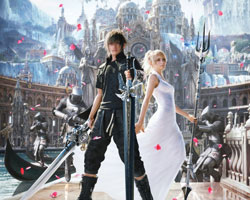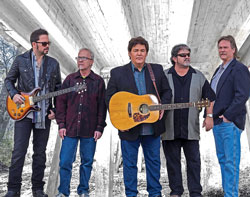Final Fantasy is one of the longest running series of Japanese Role-Playing Games (JRPG’s); the fact that the core series just released its fifteenth title is testament to this. Each numbered Final Fantasy title takes place in a unique world, with new characters and plot elements, yet most titles have a number of features tying them together. Final Fantasy games are all fantasy titles, typically rife with magic and arcane technology; recurring elements in the series include powerful magical crystals, Chocobos (birds which are ridden like horses) and the idea of a “hero of light” (the player character who brings salvation to worlds plagued by darkness).
Final Fantasy, the series’ first title, was released in Japan in 1987, however, it did not receive a North American localization until 1990, and only experienced moderate success. Final Fantasy IV was the second title to receive a western localization in 1991, and to avoid confusion, it was titled Final Fantasy II. Ironically, the protagonist and first memorable warrior of light, Cecil, was originally a dark knight in service to a cruel empire before he went on a journey of self-discovery and developed as a person. This was the first Final Fantasy game I ever played; while I personally was not infatuated with it, I did enjoy it enough to complete it, and I can see why many in the west consider it the series’ breakout title.
In 1994, Final Fantasy VI was released in North America as Final Fantasy III; many western players, myself included, consider this title to be the series’ first masterpiece. The original western localization received some censorship, specifically, the removal of several minor instances of profanity/nudity that, by today’s standards, wouldn’t even raise an eyebrow. This title was notable for introducing magitek (the fusion of magic and futuristic technology) to the series, featuring a dark plot, a twisted villain (Kefka, nicknamed “the psycho clown” by fans), and dealing with dark, mature themes, such as suicide. The game’s protagonist, Tera, is also worthy of note for being Final Fantasy’s first female protagonist, along with being regarded as one of its best.
Final Fantasy VII was released in both Japan and North America in 1997, and is probably the most popular title in the series. The world of Final Fantasy VII is one of the series’ most well-constructed settings, and its cast featured a number of interesting secondary characters, along with a phenomenal antagonist. Environmental destruction by Mako reactors in FFVII parallels the modern-day crisis of global warming, I feel this theme struck a chord with much of the game’s audience. As a testament to its legacy, Final Fantasy VII is due to receive a full modern remake for the PS4, something which fans had been demanding for years, and I am personally quite excited for.
Final Fantasy VII: Crisis Core was developed as a prequel to this entry, it released on the PSP (playstation portable), a rather unsuccessful platform which likely functioned to impede its success. Personally, I consider it to be Square Enix’s best Final Fantasy spinoff and better than the title which spawned it.
Final Fantasy VIII released in 1999, and is commonly regarded as having the series’ best protagonist, Squall Leonhart (a sentiment I agree with whole-heartedly). What makes VIII such a great Final Fantasy is Squall’s internal dialogue, and the game’s development of him as a character. Between his personal growth and self-discovery, I found my impression of him completely transformed by the conclusion. A famous scene from this game was actually used by Sony for their Playstation 2 tech demo (the ballroom waltz scene, for those few who may be familiar with it). Personally, I consider Final Fantasy VIII to be by far my favorite Final Fantasy, and possibly my favorite video game.
Final Fantasy IX was Square Enix’s attempt to bring the series back to its roots. The scenario was simpler and lighter (less political intrigue, more character-focused) and the graphics were less realistic, bearing more of an animated/fantasy aesthetic. Zidane was also something of an irregular protagonist, being young, jovial, and having a tail (prior Final Fantasy protagonists were all human). In my mind, this title was a masterpiece, and it unfortunately was the last such title until this most recent entry.
Final Fantasy X is something of a divisive title, fans tend to either love it or hate it. Personally, while I feel that it is an excellent game, I don’t see it as being a masterpiece (it doesn’t reach the height of Final Fantasy VI, VII, and VIII). That said, in many ways, Final Fantasy X is the first truly modern Final Fantasy (it was the first core title to feature voice acted characters and was also a significant graphical leap from previous entries). It was also the first core Final Fantasy title to receive a direct numbered sequel (Final Fantasy X-2) which is notable for being the first title in the series to feature an all-female cast. Unfortunately, I can’t recommend it due to the plot being, frankly, silly.
Final Fantasy XI is the series’ first massively multiplayer online role-playing game (MMORPG). Personally, I’ve never had an interest in it; I’m of the opinion that MMO’s typically age poorly, in a large part due to plot being a secondary concern. Popular opinion is that it was more or less a successful MMORPG title, and that it set the stage for Final Fantasy XIV, one of the best MMORPGs currently available. Final Fantasy XIV released with numerous flaws to an underwhelming response, which prompted Square Enix to pull the game out of release and basically remake it, with the end result being a masterfully crafted MMORPG, and one of the only successful modern titles to successfully rely on a subscription business model.
Up until the release of Final Fantasy XV, the Final Fantasy XIII saga (made up of FFXIII, XIII-2, and XIII-3) was the most recent core title within the Final Fantasy series. Personally, I enjoyed these games, but I don’t feel that they reached previous series heights. The FFXIII saga is notable for being the second universe within the core series to feature a female protagonist (Lightning) and for its graphics, which were stunning at the time of release. However, this entry in the Final Fantasy series drew severe criticism for its linearity and the combat system, which many, including myself, felt lacked in interactivity (the game basically played itself). Personally, I much preferred the Final Fantasy: Type-0 spinoff of FFXIII, which was the first M-rated Final Fantasy title in the series. Its notable for featuring action combat, an open world, social sim elements, and graphical violence.
IMAGE TAKEN from www.ultimafinalfantasy.geekdomentertainment.com



